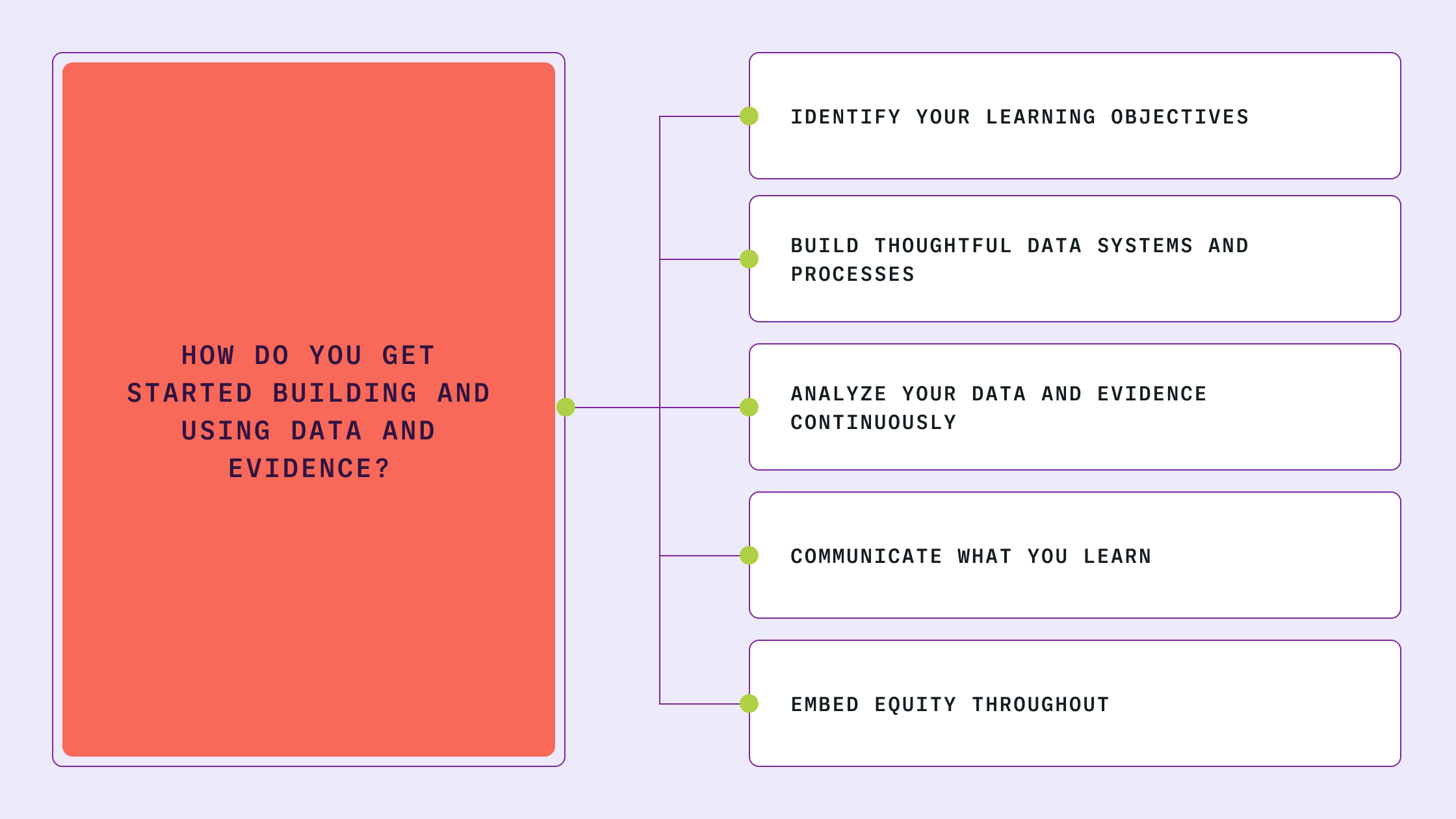A Beginner’s Guide to Evidence Building

What is evidence—and why do you need it?
Evidence is data (quantitative and qualitative information) plus analysis—enabling it to answer questions and inform actions.
Understanding your impact in the social and education sectors is a complex task. While for-profit companies can look at their sales and bottom lines to understand how well they’re doing, nonprofits and social impact organizations often have a harder time defining and measuring their impact. These leaders are tackling some of our biggest challenges, influenced by a web of interwoven factors and with root causes that are not always clear. How can impact-driven leaders understand and improve their progress?
That’s where evidence come in.
Evidence is remarkably powerful. It helps us understand what’s working and what isn’t, for whom, and why. It guides critical decision making and enables continuous learning, innovation, and improvement. And it deepens a shared understanding with staff, board, funders, and community members, helping you accelerate and communicate the impact of your work.
In the face of compounding inequities across education, health, housing, employment, and economic security—we need data and evidence now more than ever. Evidence can shine a spotlight on who is being left behind, who doesn’t have equal access to opportunities, and where targeted investments can improve outcomes for everyone. Evidence can also help us direct limited resources and programs where they are needed most and where they can have the greatest impact.
How do you get started building and using data and evidence?

Identify Your Learning Objectives
Your evidence-building strategy should be grounded in your organization’s strategy and theory of change. (A theory of change outlines a set of facts and hypotheses about how your activities are expected to lead to the outcomes you hope to achieve.) How can evidence help advance your organizational priorities? What questions are you trying to answer? Some examples we’ve heard from partners include:
- How can we understand and improve the impact of our work for vulnerable communities?
- How should we prioritize program investments and activities given our limited resources?
- How can we expand our reach to meet the needs of more people and communities in need?
- How can we shift from measuring outputs (how many students did we serve) to focusing on impact?
Identifying and aligning on your learning questions will allow you to develop an evidence-building plan rooted in your strategy and goals.
Build Thoughtful Data Systems and Processes
Chances are, your organization is already collecting a fair amount of data—from financial data to program participant demographics. But are you collecting the right types of data? Is the data stored in a way that’s accessible to staff at all levels and facilitates decision making, learning, and improvement? Assessing the systems and processes your organization uses to collect and manage data will allow you to understand what data is currently available and how it’s organized. This will in turn help you identify and implement improvements to ensure your data collection is continuous and disciplined, that data is accessible to key stakeholders, that you have proper data governance protocols in place to ensure privacy and security, and that your data collection efforts are in support of your strategic goals.
Analyze Your Data and Evidence Continuously
For data to transform into evidence, it can’t sit in a black hole. Building your organizational capacity to routinely analyze both quantitative and qualitative data and interpret findings will result in actionable evidence that can guide decision making, inform learning, and improve service delivery to more adequately address community needs. This often includes leveraging pertinent external data and evidence to assess needs and understand what has worked for others. Over time, developing a structured, continuous process of building and analyzing evidence will enable you to improve programs, test new ideas, and better understand your impact.
Communicate What You Learn
Evidence can tell a compelling story, supporting social sector leaders in building movements, driving policy change, raising funds, and engaging with community members. Strong data and evidence have been catalysts behind many successful social change movements. And being transparent about both your successes and challenges builds trusting relationships with key stakeholders, including staff, board members, funders, students, families and community partners. Incorporating data and evidence into your storytelling is a powerful way for your organization to amplify its voice and impact.
Embed Equity Throughout
We believe that evidence is a key driver of equity. It can shine a light on those who have been overlooked and help us understand what works (and what doesn’t), for whom, and under what conditions. Achieving equitable outcomes requires that principles of equity inform how an organization generates evidence and evaluates outcomes. This includes:
- Considering systems, policies, cultural norms, existing biases, and community conditions that drive inequity, especially those related to poverty and racism.
- Empowering program participants and community members to shape and participate in the process of building evidence and interpreting results.
- Developing data collection tools and processes that are respectful and responsive to the needs of different groups.
- Building capacity for continuous dialogue, reflection, and other learning activities at all levels of your organization.
- Intentionally using data to determine differential impacts on populations served and identify areas of improvement toward meaningful and equitable outcomes.
For many leaders, starting out on the journey of building and using evidence can feel overwhelming. But the good news is there are small steps any organization can take to begin collecting and applying data and evidence more strategically. And you don’t have to do it alone! Project Evident works with organizations at all levels of evidence capacity, meeting you where you are to help you achieve your objectives. Our Equitable Outcomes Wallet provides free resources and coaching to early-journey organizations, with a particular focus on organizations led by women and people of color. The evidence-building journey can be long and filled with twists and turns, ups and downs—but by being thoughtful about why and how you’re engaging in this work, you can harness the power of data and evidence in service of stronger, more meaningful, and more equitable outcomes for those you serve.